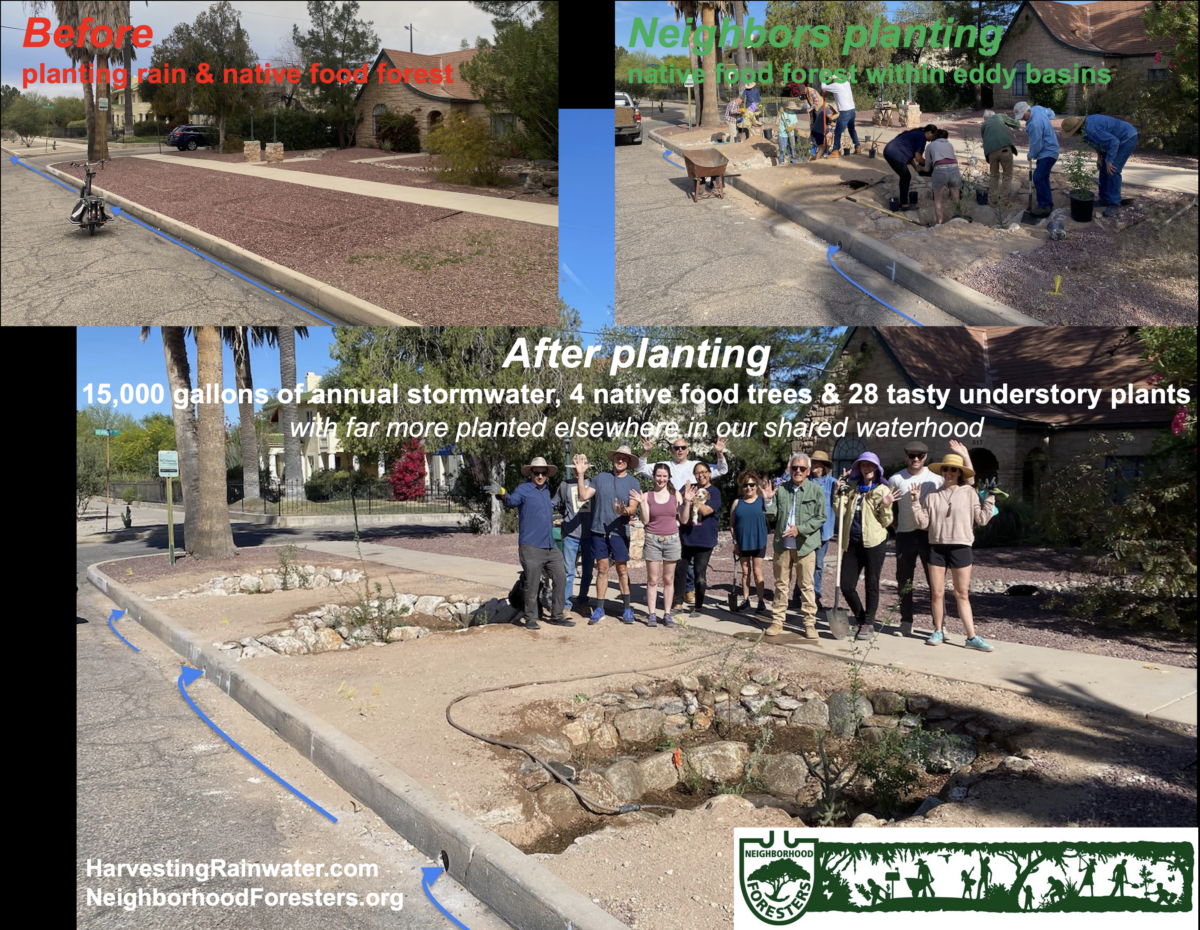Our 27th annual Dunbar/Spring Neighborhood Rain, Tree, & Food Forest Planting extended into the adjoining West University Neighborhood for a fourth year here in Tucson, Arizona.
But as both neighborhoods are part of/share the same watershed, you could say we planted in just one waterhood.
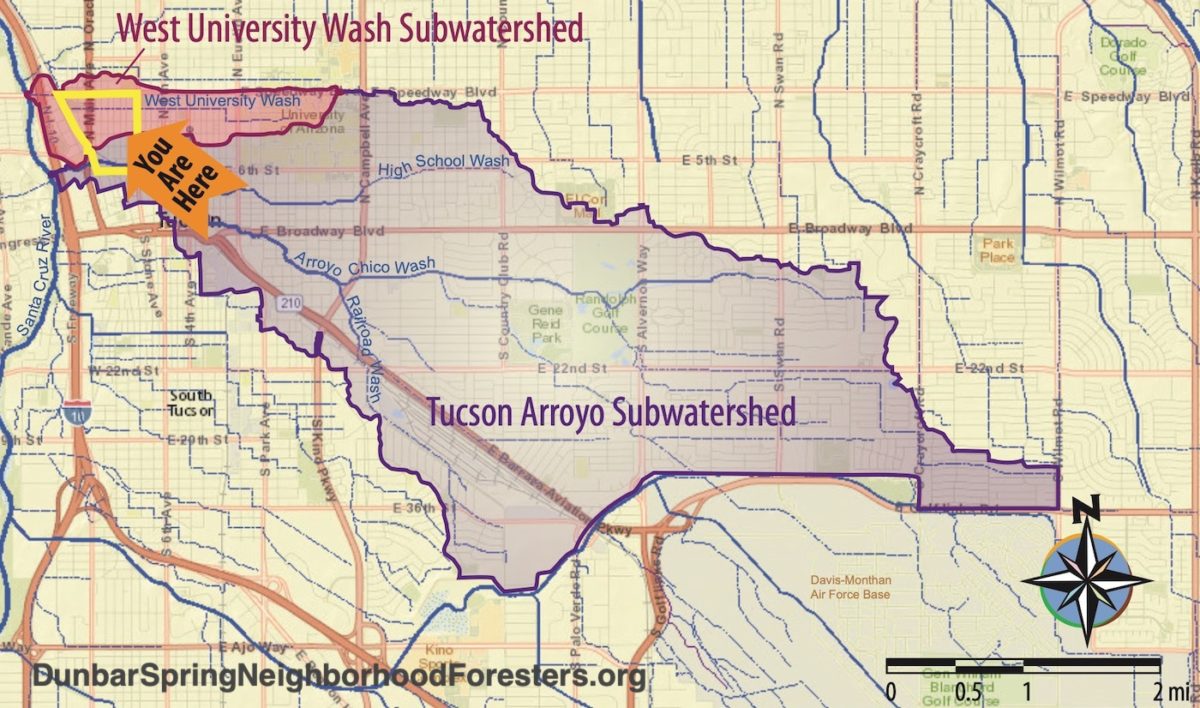
In total, during our 2023 planting, we planted:
• Over 60,000 gallons of stormwater (that will be captured in the constructed street-stormwater-harvesting earthworks in an average year of rain). (This water used to wastefully drain out of the neighborhoods, dehydrating them and creating downstream flooding).
We plant the rain before we plant any plants, so after establishment, passively-harvested rainwater and stormwater will be the sole irrigation source of the plantings.
• 17 native food-bearing trees that will grow to full size (some of these were planted within rain gardens created in previous years where trees were mistakenly removed by outside “maintenance” crews).
• 19 bush trees (see here for an example)
• 114 native, multi-use understory plants
• Quarter pound of Wildlands Restoration’s Short Stuff native wildflower, groundcover, and grass seed mix; and Bosque del Bac Restoration seed mix, along with neighborhood-grown coyote gourd seed and datura seed.
Volunteers who helped plant:
58
Neighborhoods represented by the volunteers that helped plant:
15
Neighborhood blocks of public pedestrian paths cleared of gravel/rock, pruned, and widened to five feet—to regain full pedestrian access:
2
Four-inch diameter curb cores made to direct street runoff into street-side basins:
13
Existing driveway dips in street curb used as street-side basin inlets:
3
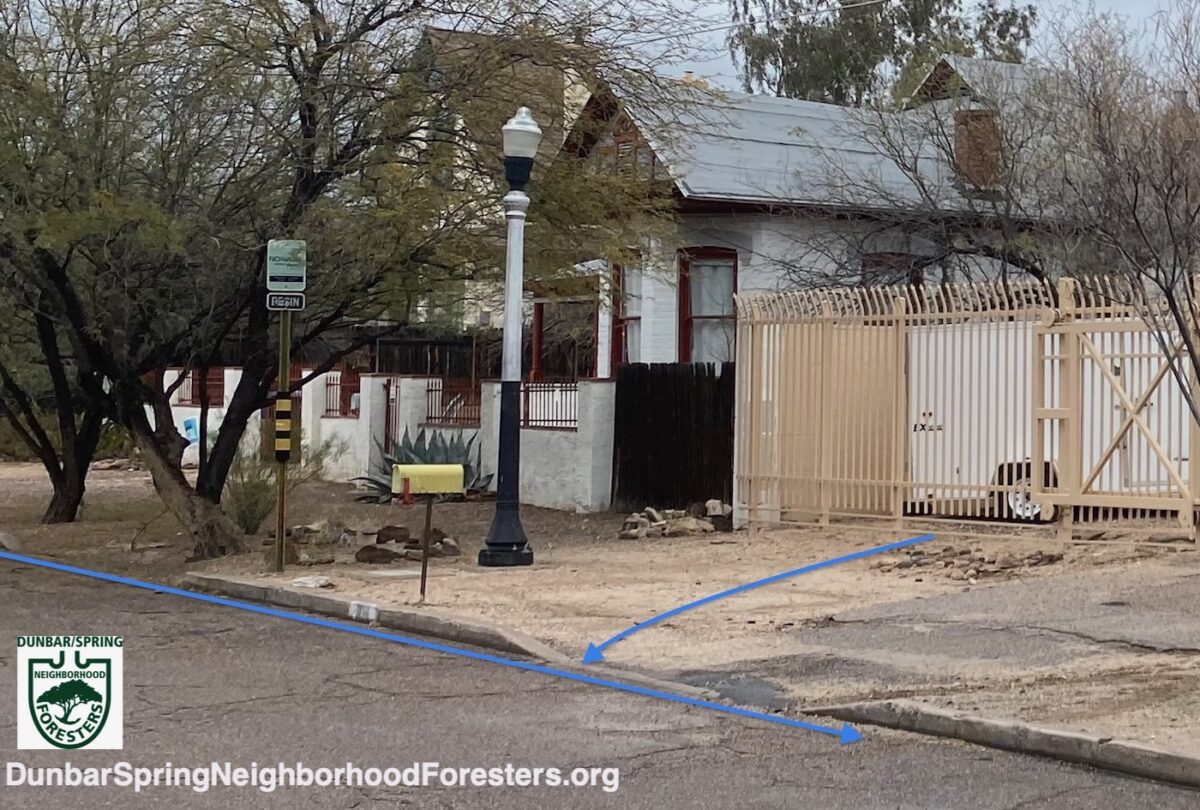
Free stormwater is wastefully and erosively drained away.
Photo: Brad Lancaster
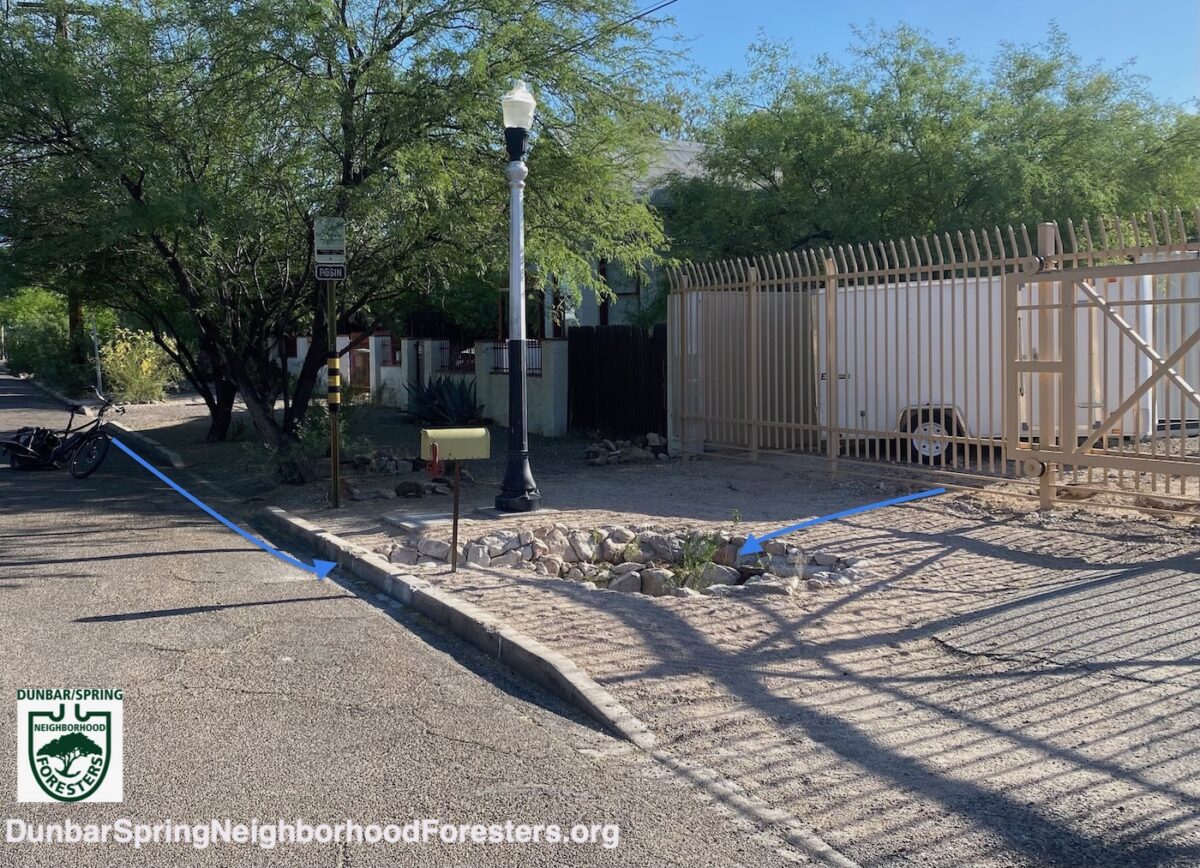
Free stormwater is wisely harvested and utilized in a way that this system gives back more water to our hydrologic system than it takes from it.
The water harvested within this eddy basin will provide all the water needs of the basin’s plantings (once they are established), and ALSO provide water for the surrounding trees whose roots extend well beyond three times the diameter of their shade canopy.
Photo: Brad Lancaster
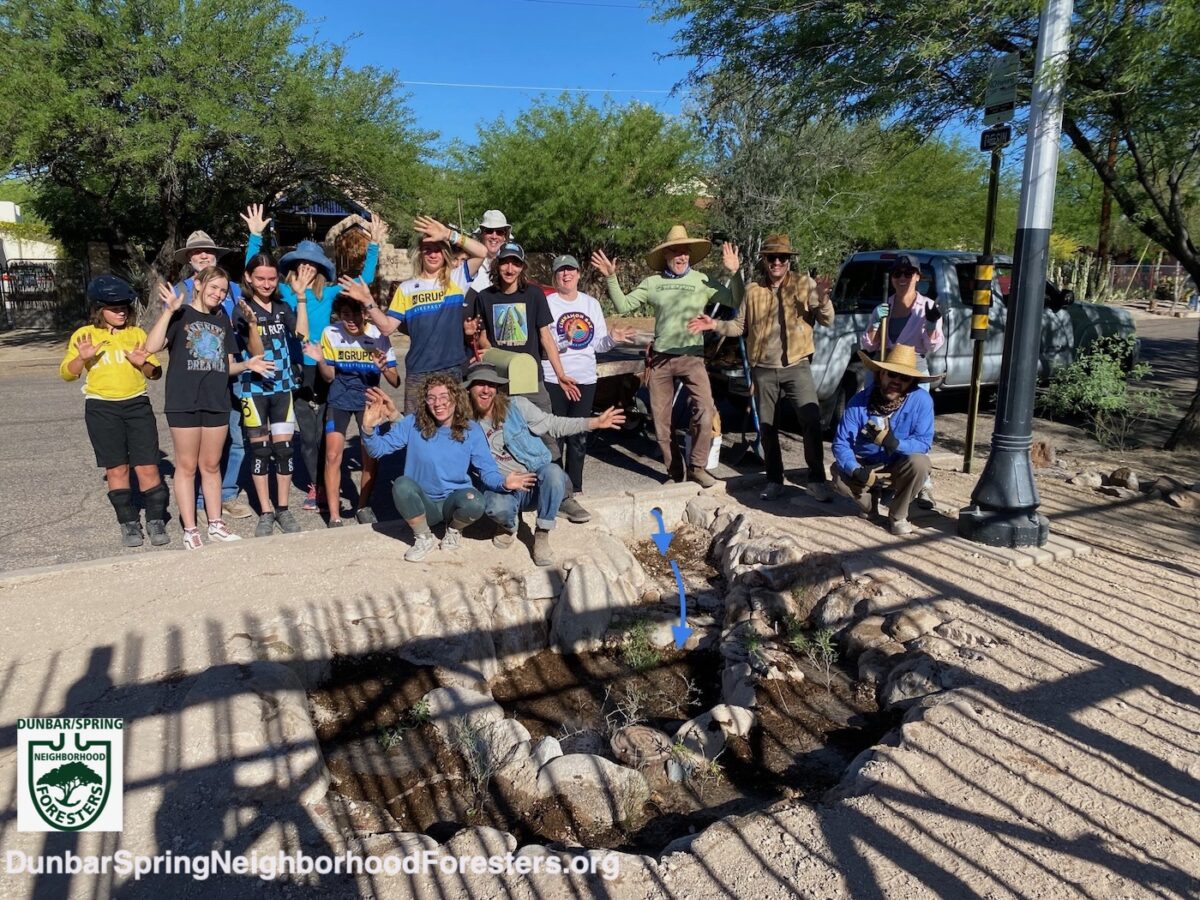
This is a street-runoff-harvesting eddy basin.
Photo: Brad Lancaster
Organizing, community outreach, permitting, and coordination
Dunbar/Spring Neighborhood Foresters
Design & plant selection
• Brad Lancaster of Rainwater Harvesting for Drylands and Beyond
Contractors we collaborated with to create the earthworks pre-planting, and the curb core holes post-planting:
• Little John Excavating
• Dryland Design
• Tucson Concrete Cutting
Local plant nurseries from which we sourced the plant material:
• Desert Survivors Native Plant Nursery
• Nighthawk Natives Nursery
• Spadefoot Nursery
• Wildlands Restoration
Local company from which we sourced the Catalina granite to line the basin banks
• Churchman Sand & Gravel
Huge thanks to the many volunteers that helped plant out all these water-harvesting earthworks!
We couldn’t do it without you, and you all can now further spread these good practices and knowledge deeper throughout our community.
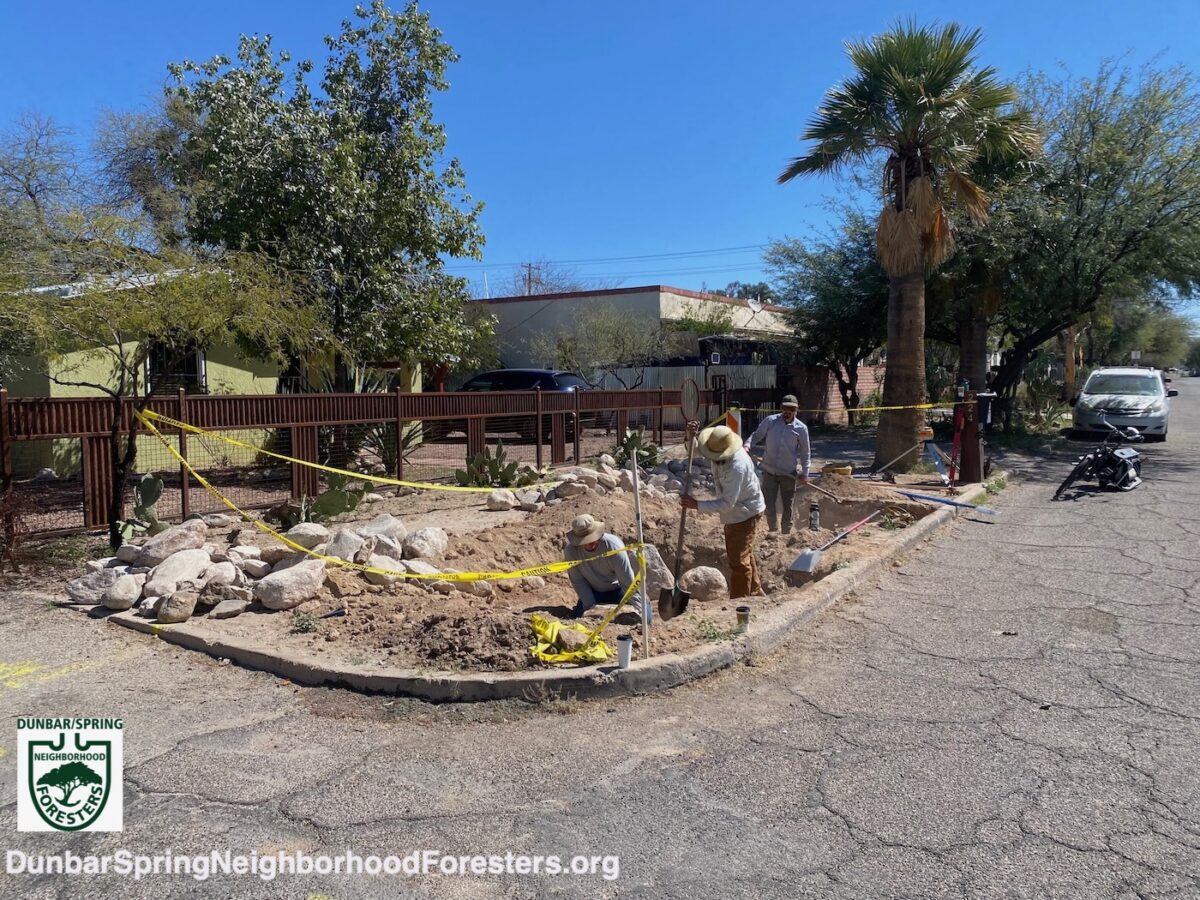
Photo: Brad Lancaster
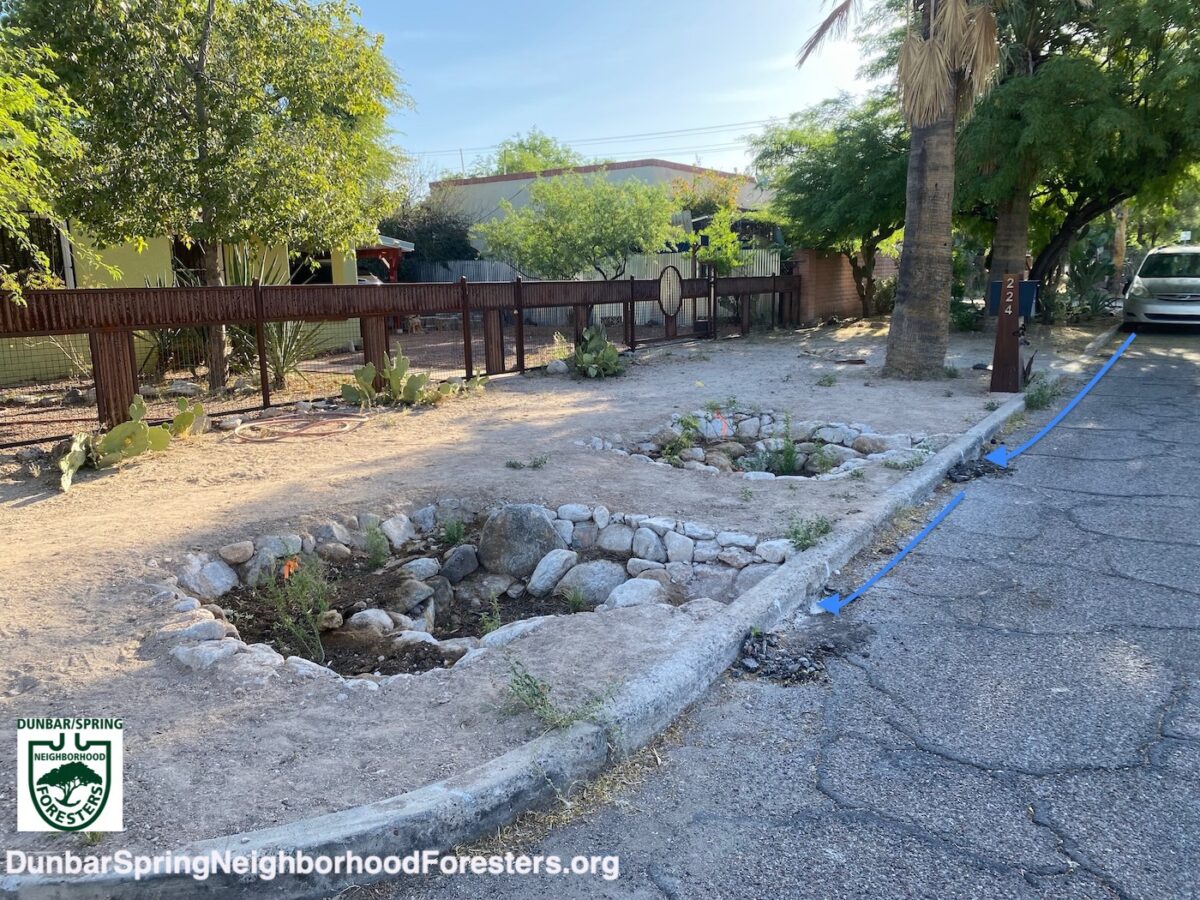
We plant 5-gallon-size trees and basin bottom bush trees, while all other plantings are 1-gallon size. This saves money compared to larger plants, makes planting easier, and results in the plants establishing (being able to subsist on passively harvested irrigation alone) sooner.
We plant native trees and understory plants at the same time to grow all layers of the native food forest. This also makes everything easier. You’ll be watering the trees the first year or two to get them established, so you can water the understory plants at the same time.
Basin bottom and planting terrace is mulched with composted goat bedding from the neighborhood goats. No amendments are mixed into the soil, instead they are placed atop the soil as mulch.
Photo: Brad Lancaster
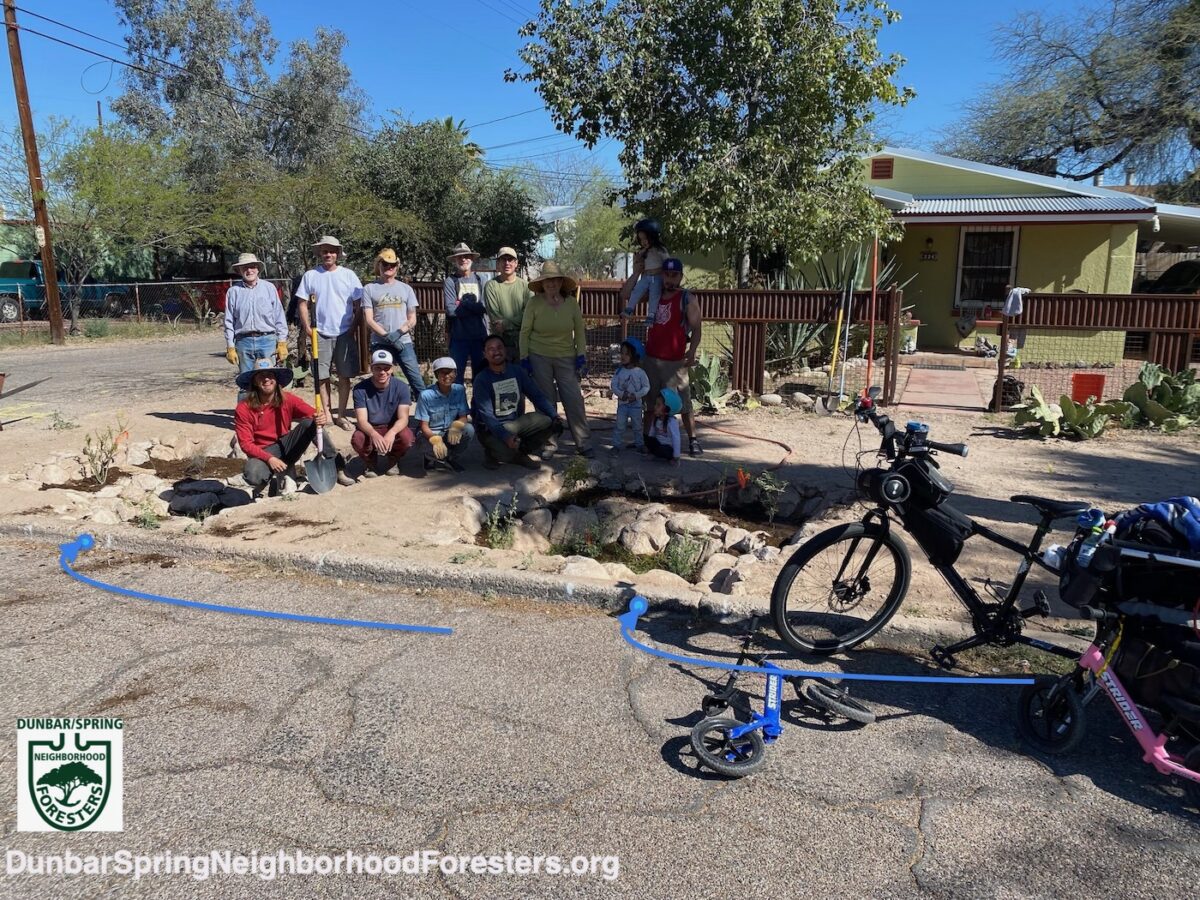
Everyone getting basins is expected to help plant their basins and those of their neighbors to build community and learn the ins and outs of how these systems work, and their role in them.
Photo: Brad Lancaster
Spread the word for next year
If you live within this waterhood share this with you neighbors, as we’ll be taking orders for the 2024 plantings in November 2023. Check our Events page and Blog later this year for updates. Or better yet, sign up on our Contact page.
And if you live in this or a different waterhood, consider starting up a neighborhood forester effort in your neighborhood (we can help you).
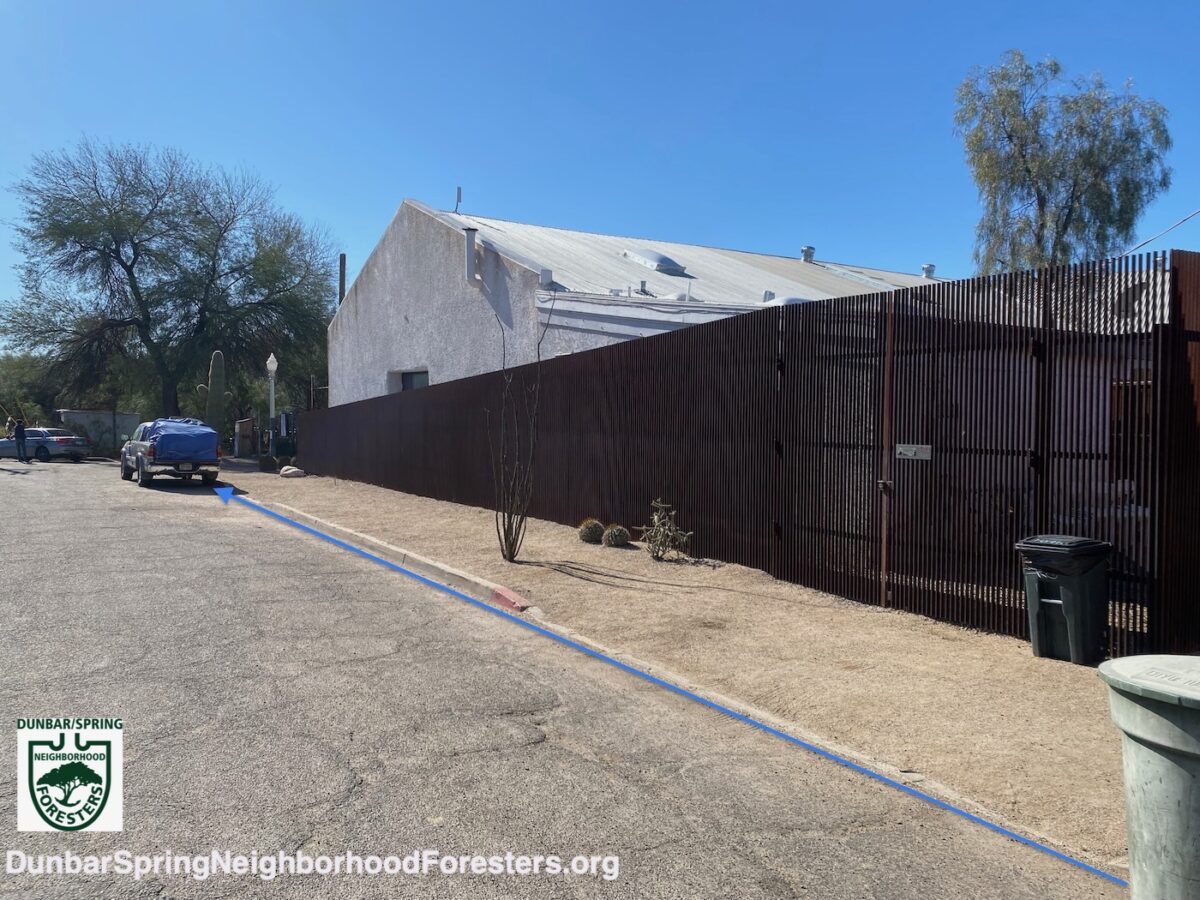
Cactus along fence will be transplanted elsewhere to widen the public footpath to the City’s minimum required width of 5 feet, to enhance the pedestrian experience and enable folks to walk side-by-side.
Photo: Brad Lancaster
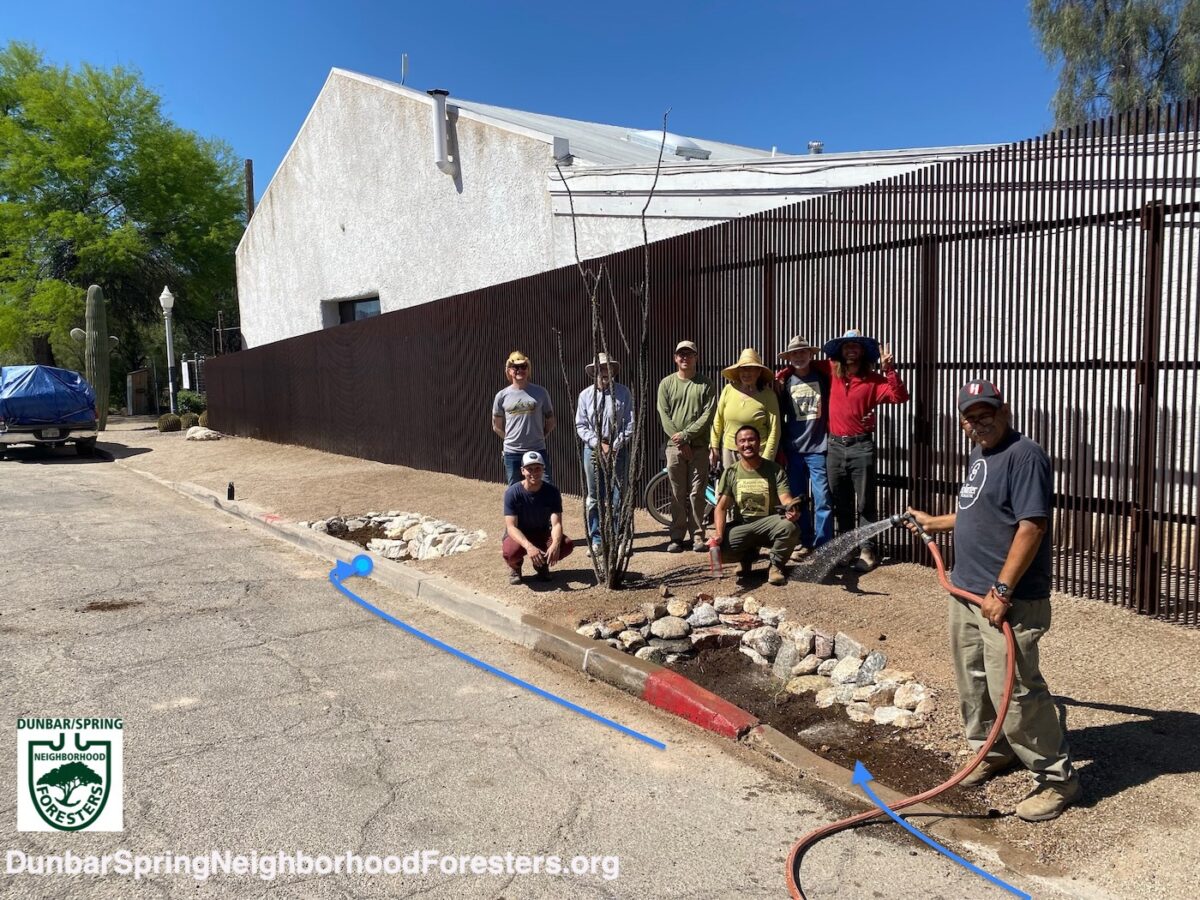
Plants are irrigated (in this case with city water from the hose) for first one to three years to get them established. The first year they have the highest supplemental irrigation needs. They get less and less each year after as the plants’ root systems grow and the soil life becomes more vibrant.
After that they are irrigated solely by the passively harvested stormwater, with surplus helping directly recharge the aquifer
Photo: Brad Lancaster
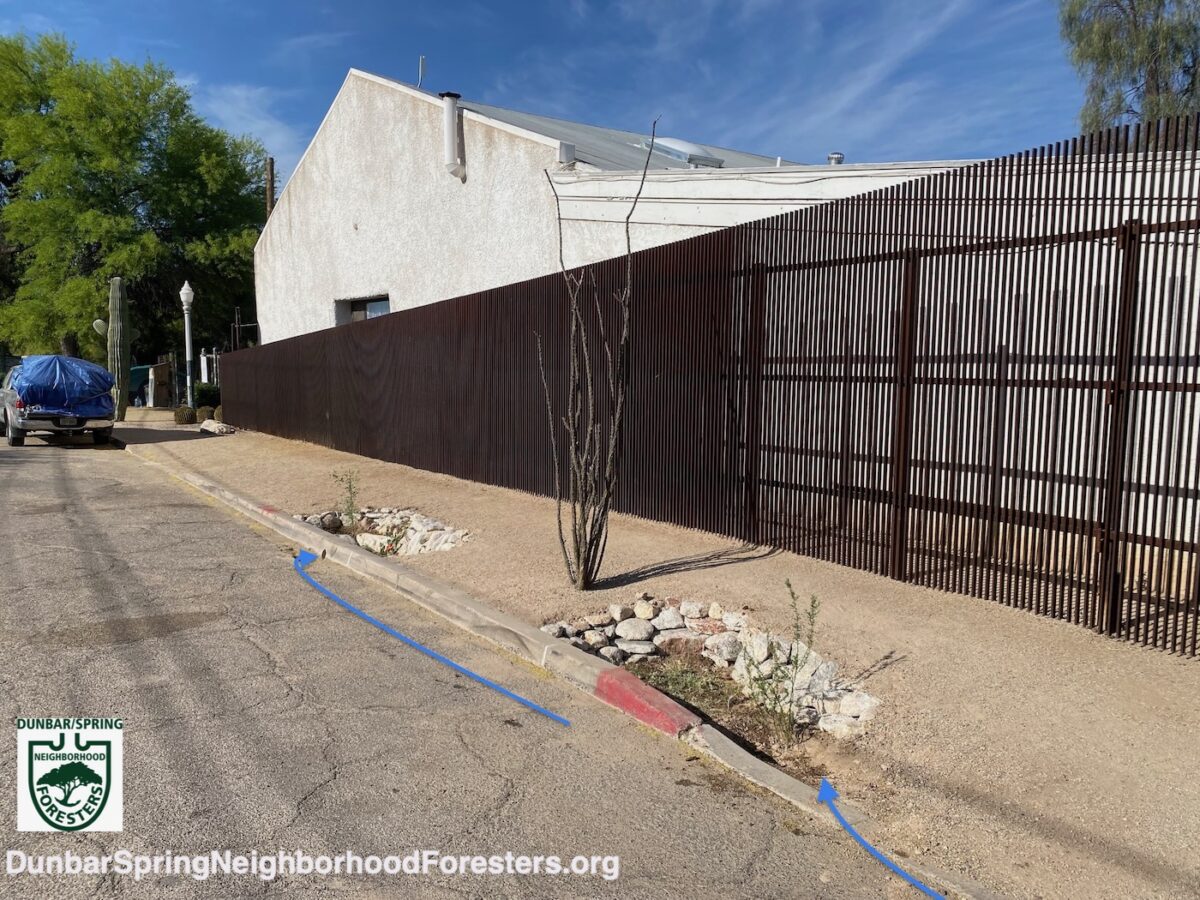
We maintain a minimum 5-foot wide continuous pathway in the public rights-of-ways to enhance, rather than degrade, the walkability and access throughout our neighborhood forest.
Photo: Brad Lancaster
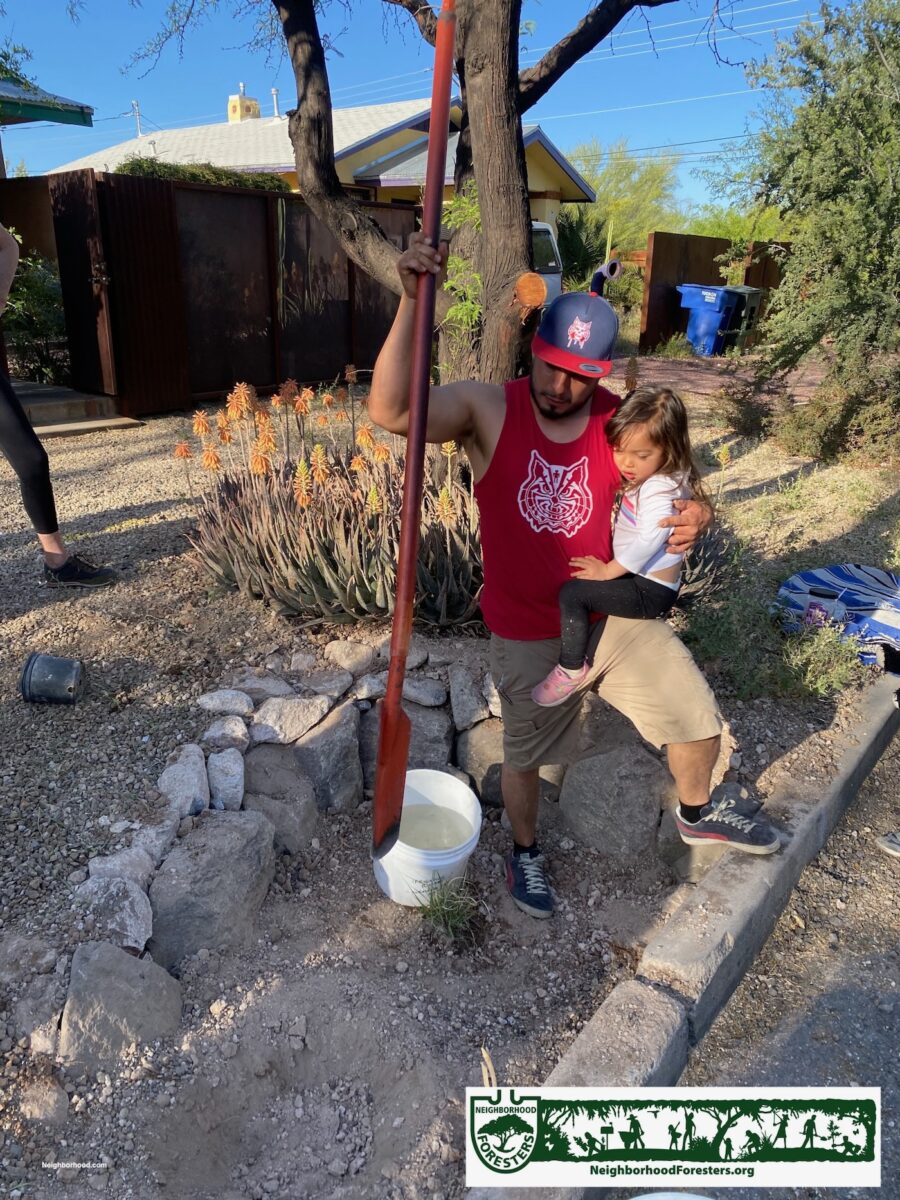
Thanks to Armando Sotelo and the triplets from Barrio Blue Moon for doing the heavy lifting here. Neighbors from neighboring neighborhoods helping each other and learning from each other.
Photo: Brad Lancaster
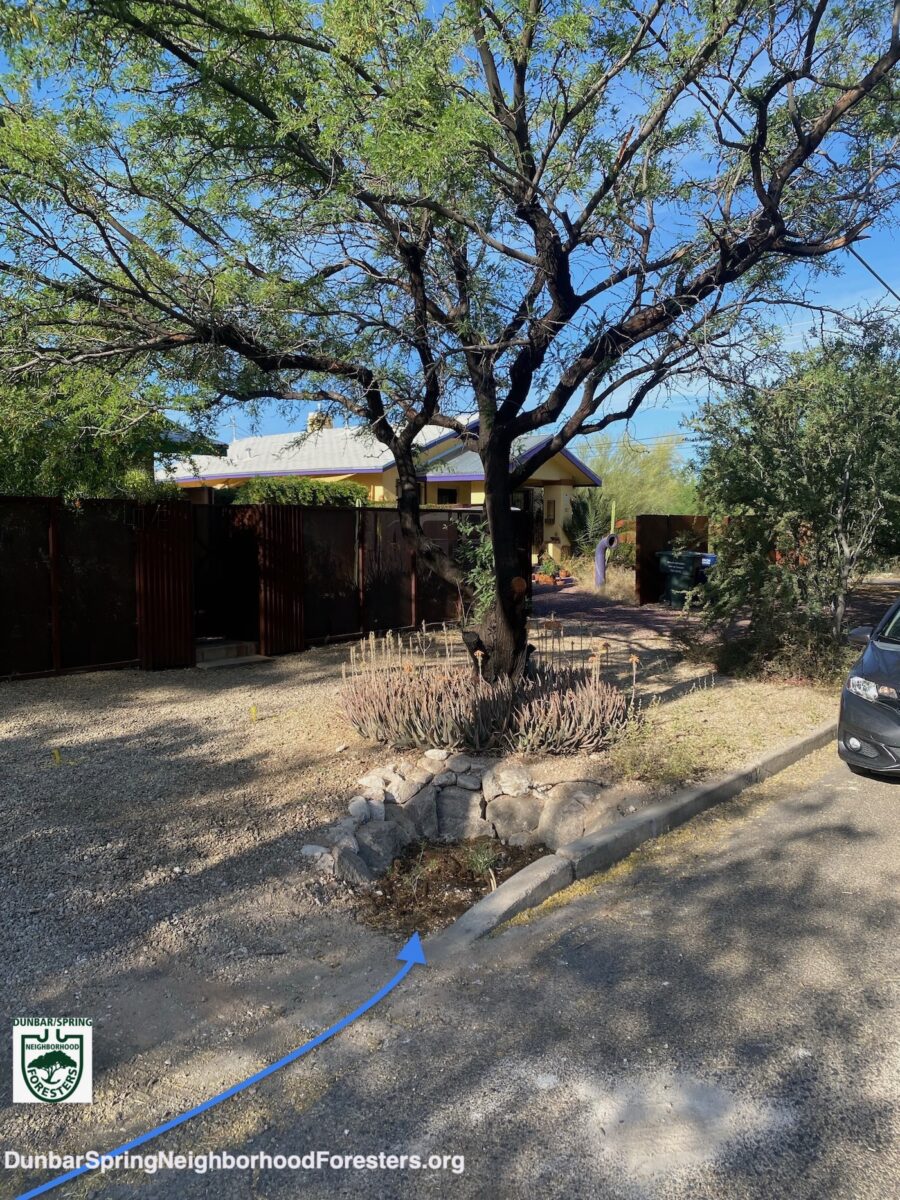
The basin is small here to minimize disturbance of the existing mature mesquite tree.
Photo: Brad Lancaster
Water harvesting books for more info:
Rainwater Harvesting for Drylands and Beyond, Volume 1 and Volume 2
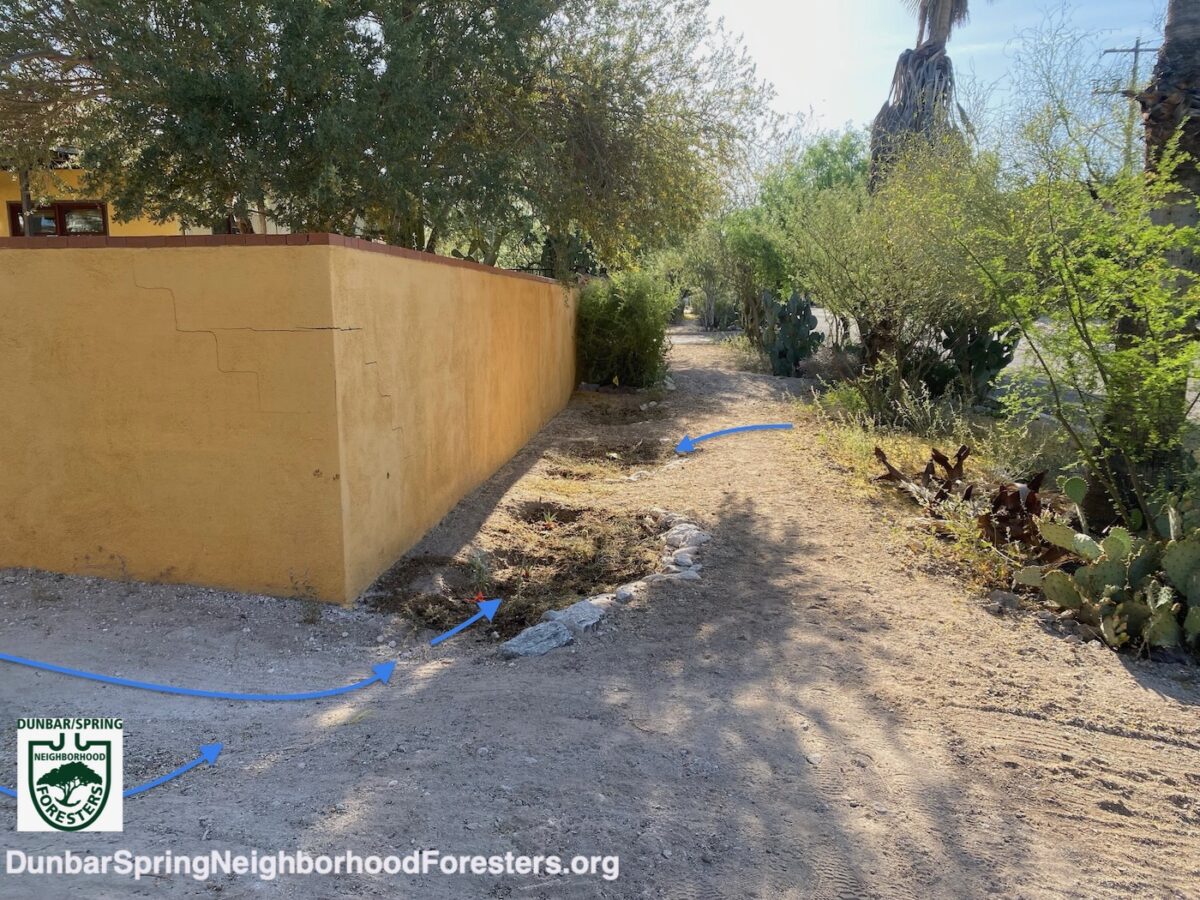
Photo: Brad Lancaster
Breakdown of the 2023 planting numbers by neighborhood:
Dunbar/Spring Neighborhood
Planted:
Over 32,000 gallons of stormwater per year
10 trees that will grow to full size
13 bush trees
68 understory plants
6 curb cores (plus, two driveway dip in curb was used instead of a curb core; and a rolling dip used to divert dirt alley runoff to adjoining basins)
44 volunteers
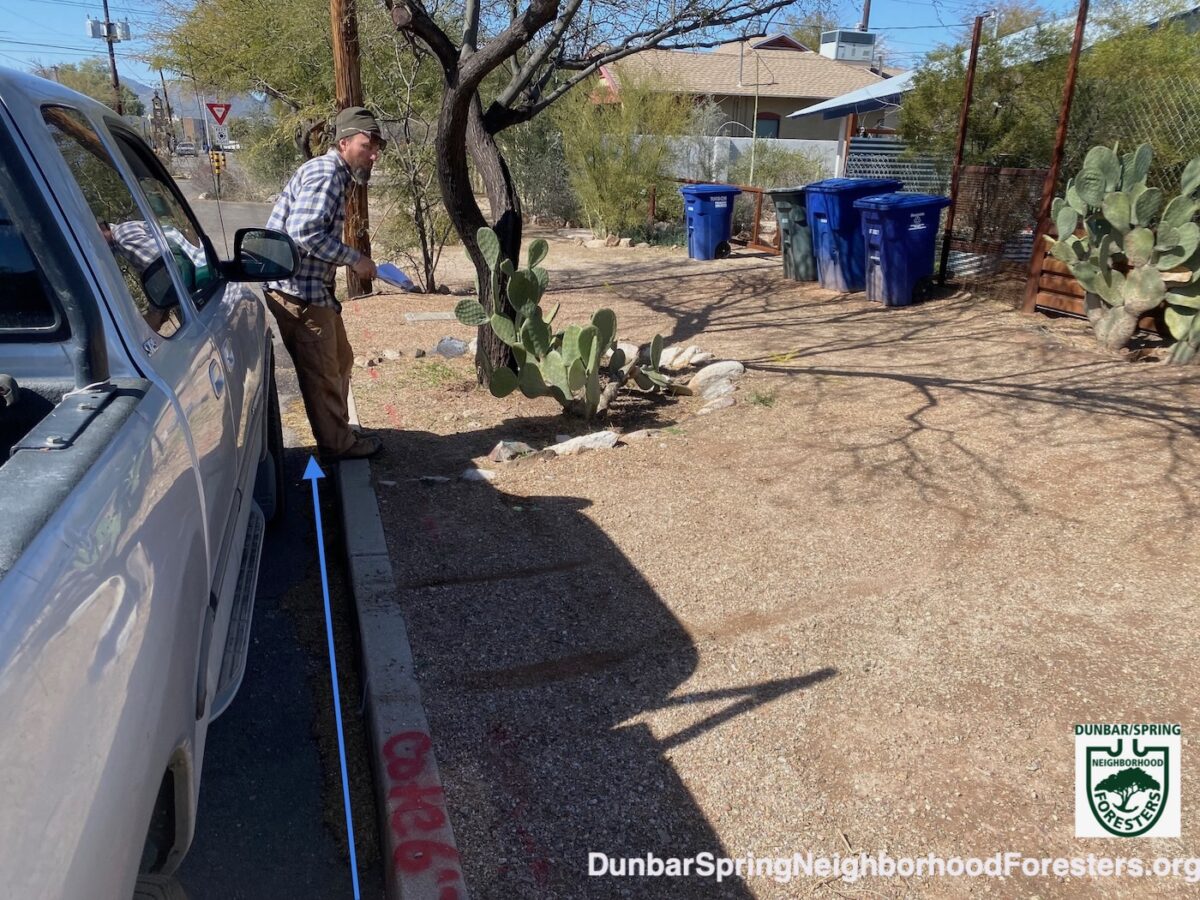
Photo: Brad Lancaster
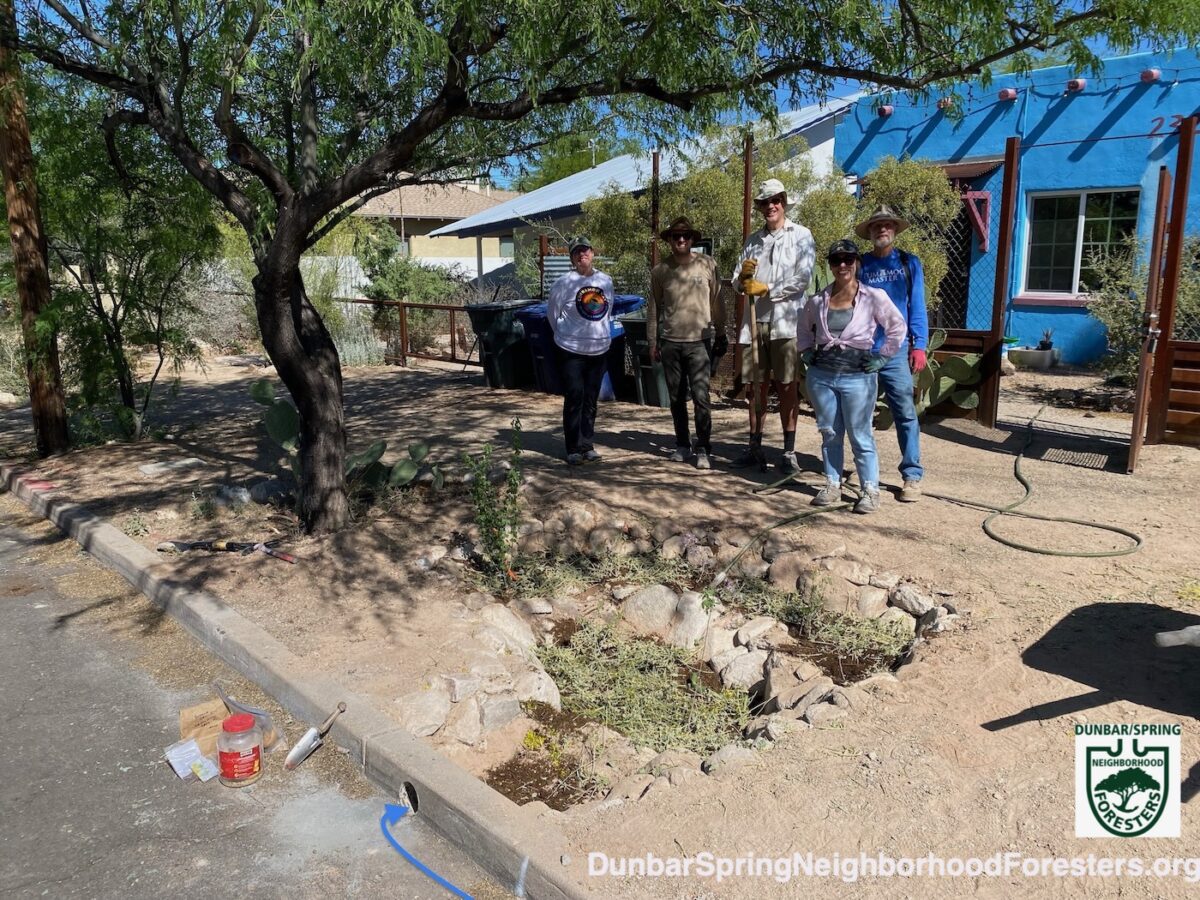
Photo: Brad Lancaster
West University Neighborhood
Planted:
Over 31,000 gallons of stormwater per year
7 trees that will grow to full size
6 bush tree
46 understory plants
7 curb core
14 volunteers
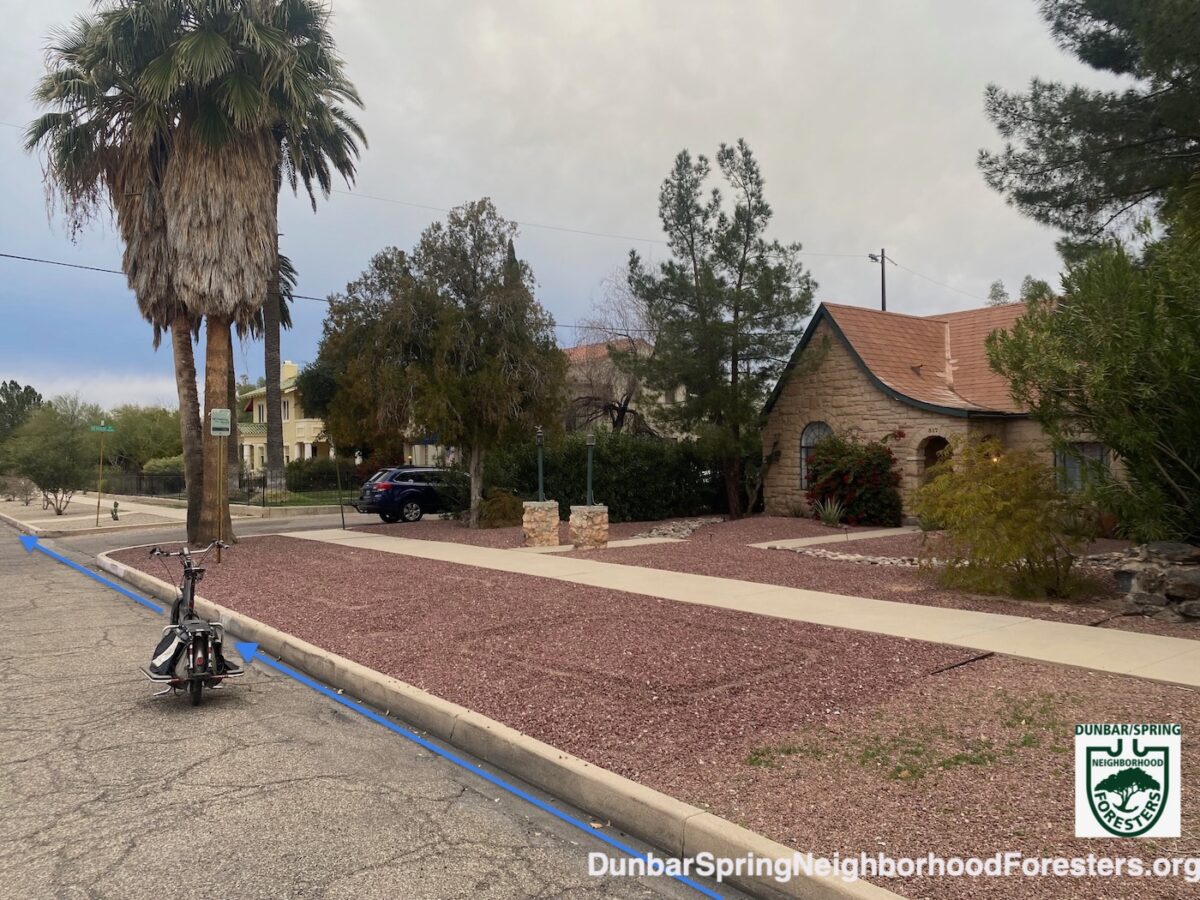
Course gravel will be removed to make for a more walkable surface for those walking between the basins. (There is a public park on the other side of this street and lots of foot traffic to and from the park).
Photo: Brad Lancaster
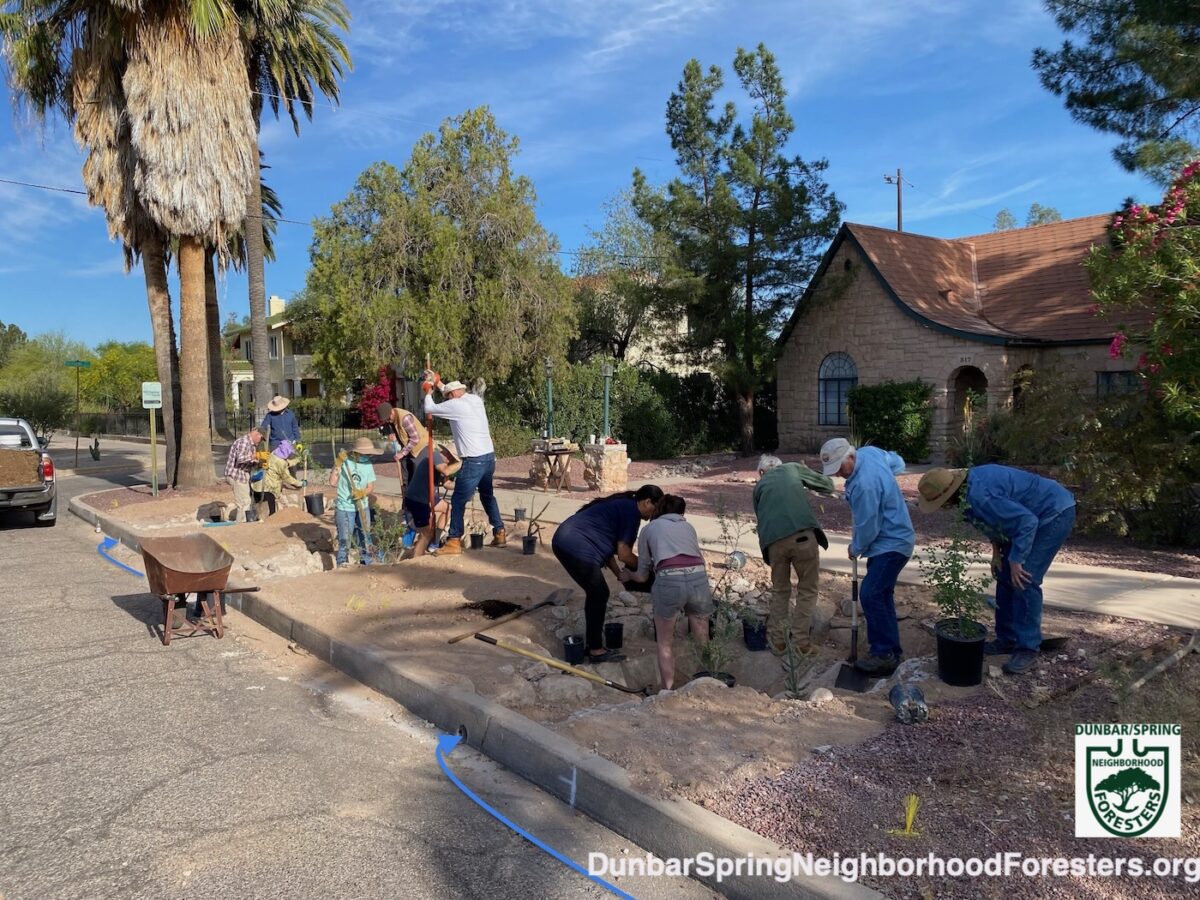
Photo: Brad Lancaster

Photo: Brad Lancaster
Please consider making a donation to the Dunbar Spring Neighborhood Foresters
so we can continue and grow these efforts, share lessons learned, and provide the organizational tools we continue to evolve to everyone:
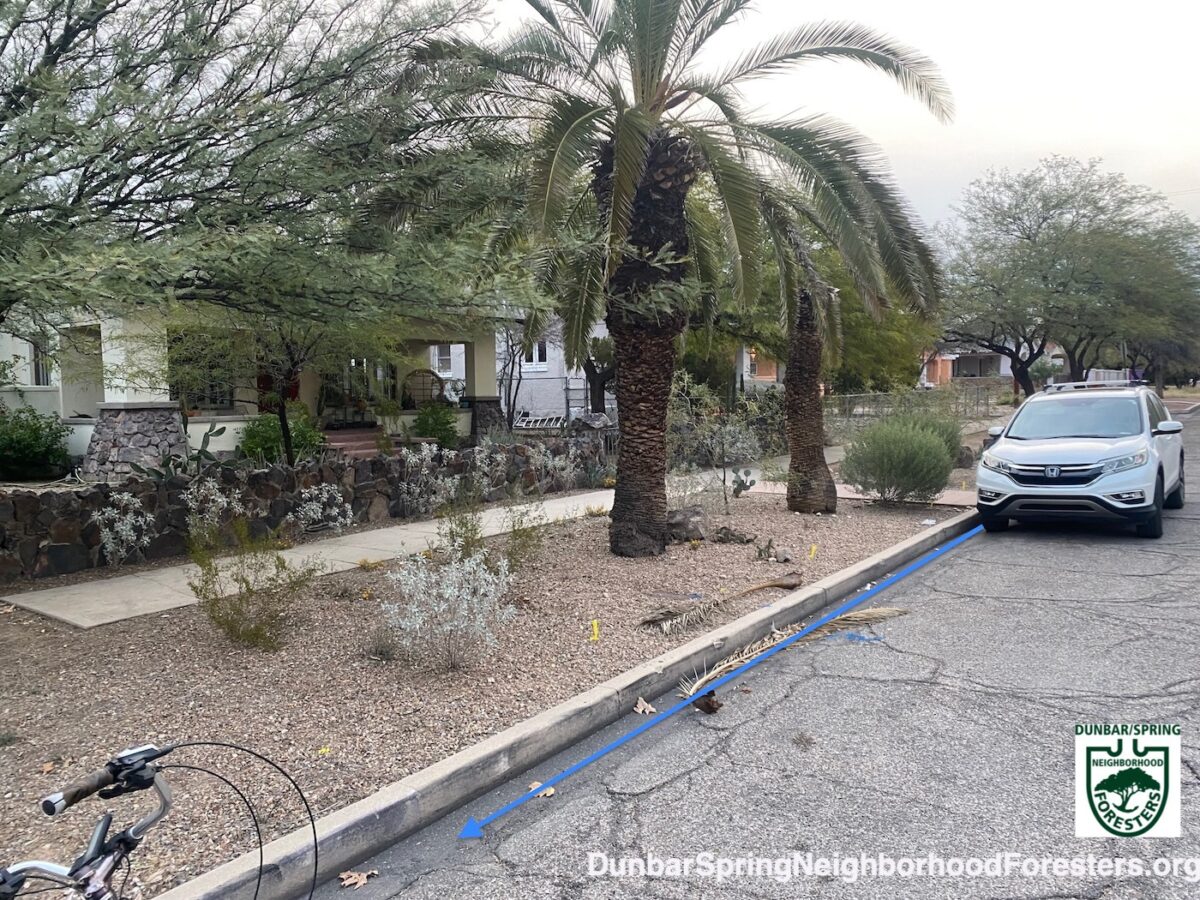
Photo: Brad Lancaster
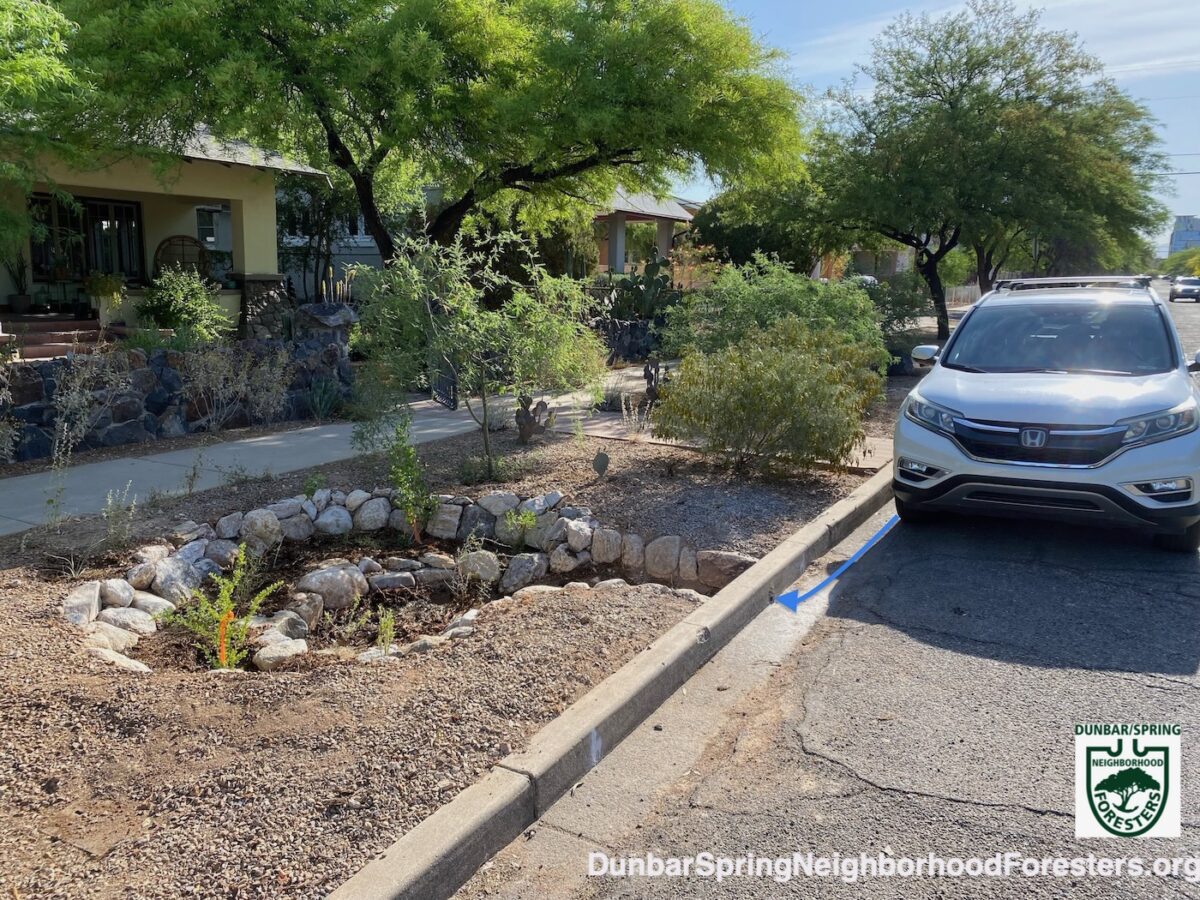
Rock is ONLY used to stabilize steep banks of the water-harvesting eddy basins.
We NEVER use rock on basin bottoms because that would reduce, rather than increase desired water infiltration into the soil and plant roots.
Three different rain garden planting zones are created in the water-harvesting basins. Bottom zone, terrace zone, and top zone to create more diverse microclimates for more diverse plantings, and to step down the drop into the basin.
Photo: Brad Lancaster
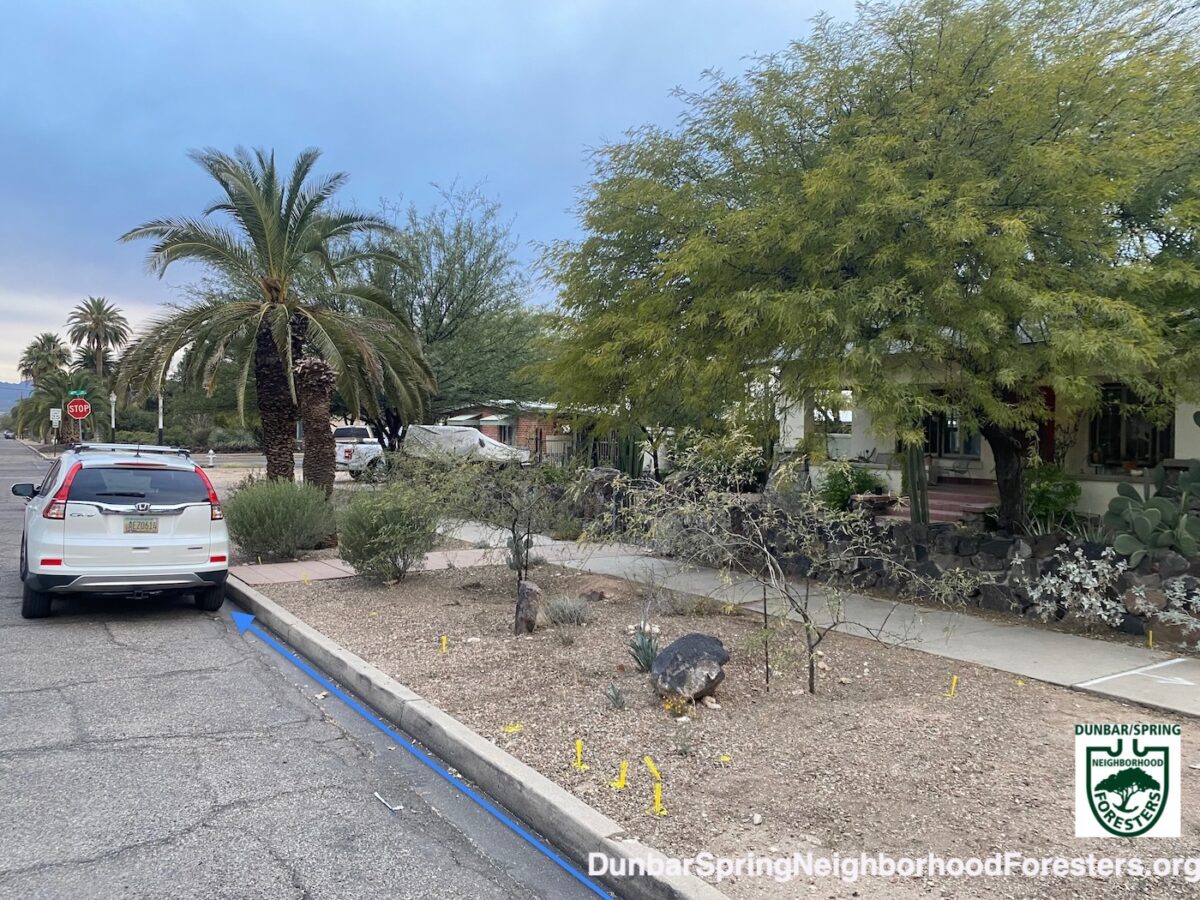
Photo: Brad Lancaster
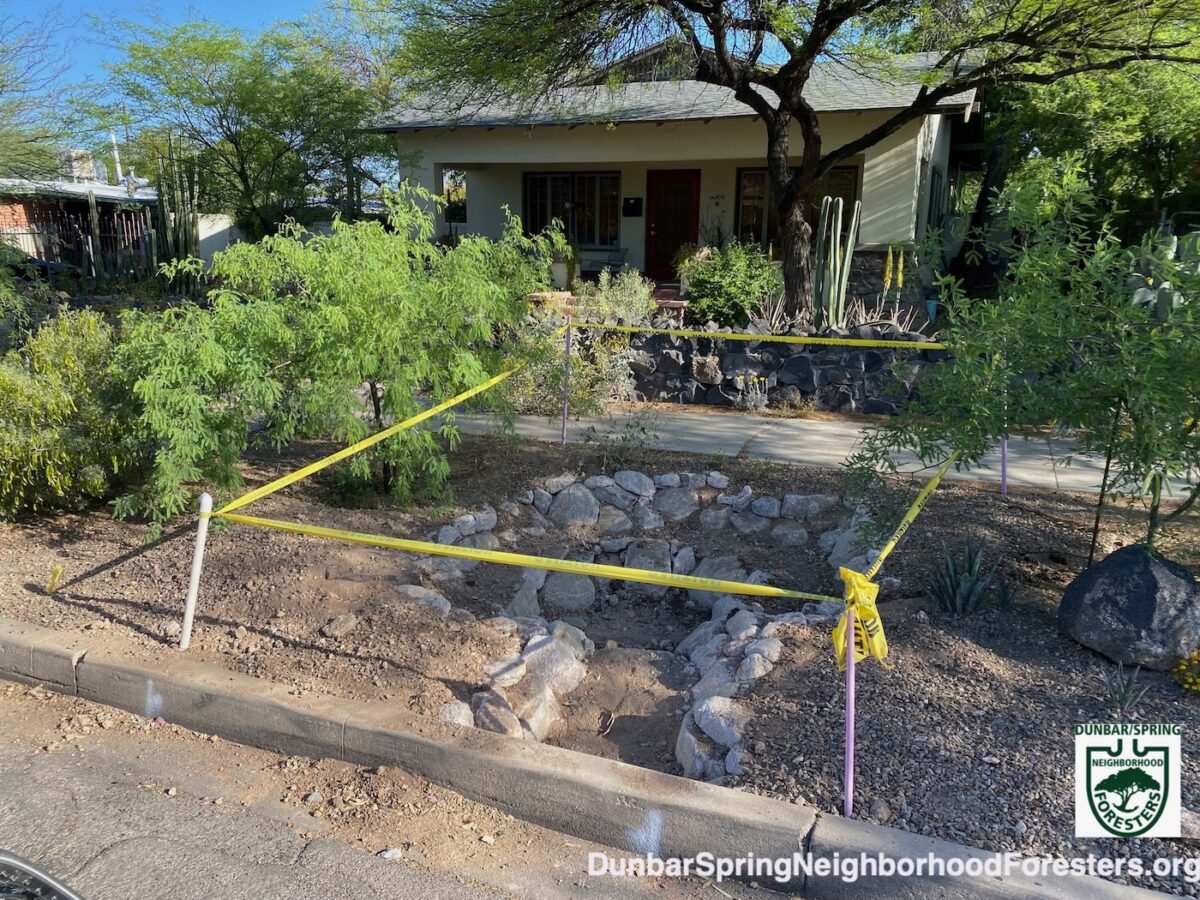
Caution tape keeps people out of the work zone until all is complete.
Photo: Brad Lancaster
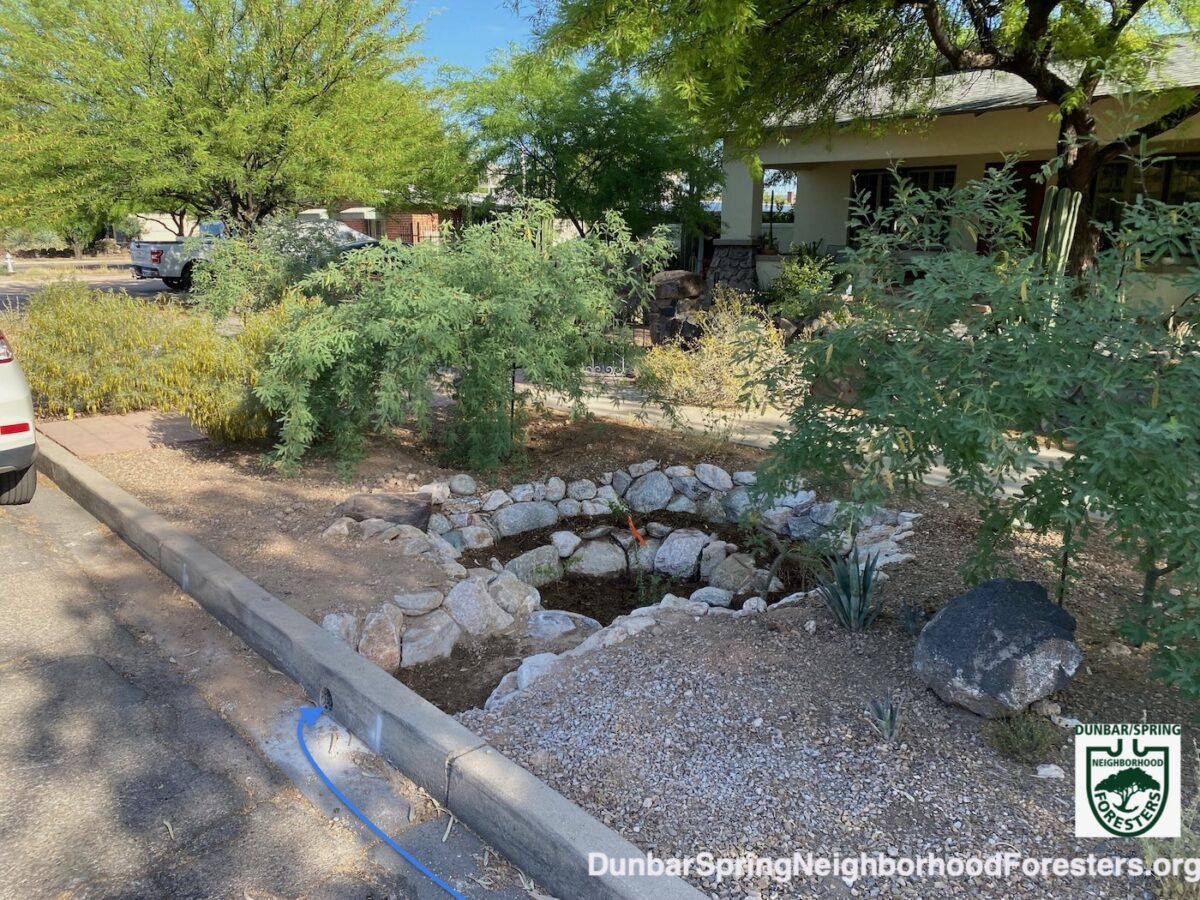
Photo: Brad Lancaster

This would’ve been the ideal site for BIG stormwater-harvesting basins and lots of trees and other vegetation to shade walkway and street, but underground utilities (water line) runs right down the middle, so we had to dramatically reduce basin size to avoid conflicts with the utilities.
We call bluestake at 811 to mark all underground utilities (its a free service) before we do our designs and installations.
And we permit all installations with the City of Tucson. By doing many sites all at once in a neighborhood we save everyone time and money by getting one permit for the whole neighborhood, rather than permits for every individual site.
Photo: Brad Lancaster
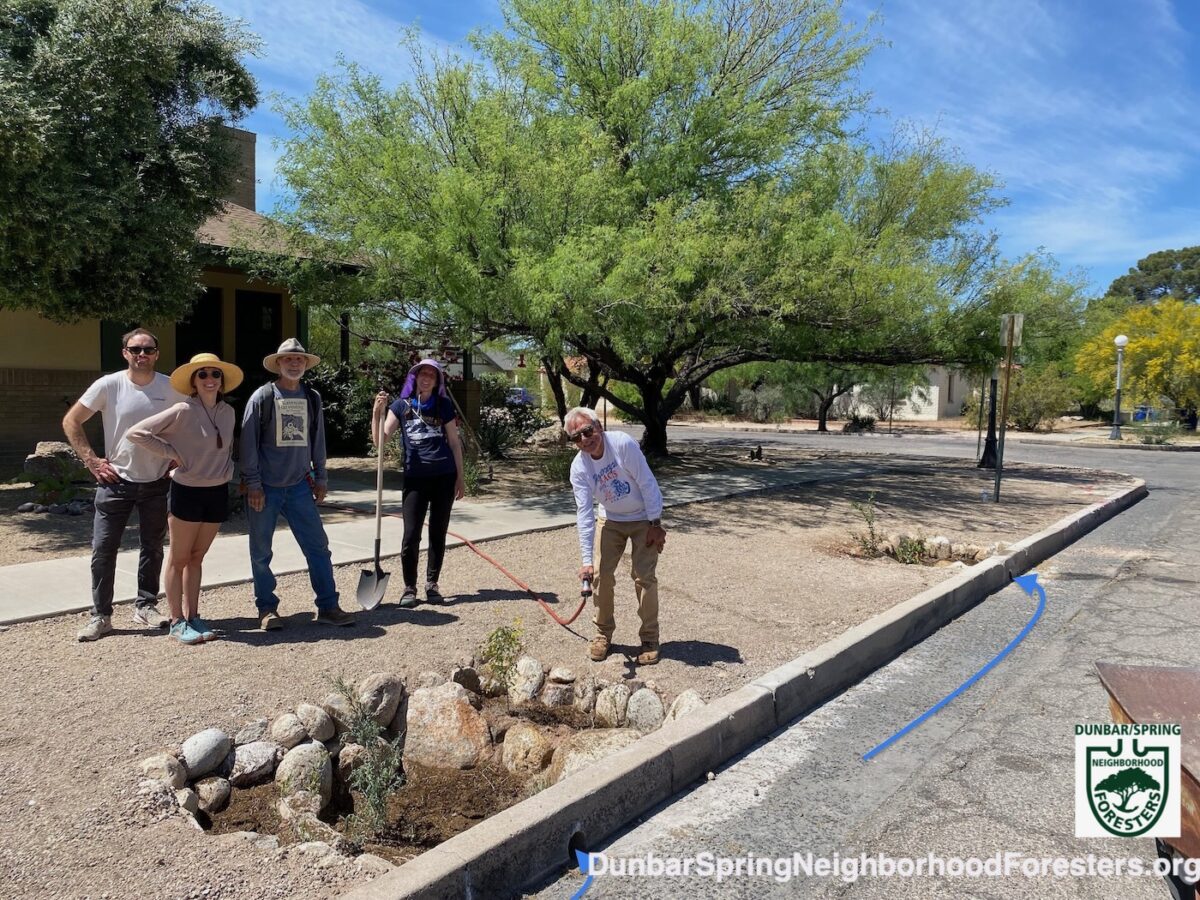
Photo: Brad Lancaster
Become a Neighborhood Forester
To see plantings from other years:
Annual rain & native food forest plantings another success in 2022
Annual rain & native food forest plantings another success in 2021



